Ali Darwish| Ninar Khalifa| Hussam al-Mahmoud| Nour al-Din Ramadan
The Autonomous Administration of North and East Syria (AANES) failed to respond to what it described as the “insuperable decisions and measures” by the administration of the Faysh Khabur border crossing, located near the Iraqi-Syrian-Turkish border tripoint and managed by the Iraqi Kurdistan Regional Government (KRG).
The administration of the Semalka border crossing— connecting al-Hasakah governorate in northeastern Syria to Iraqi Kurdistan (IK) and mirroring the Faysh Khabur crossing— retracted the decision of closing the border the same day they made the closure statement in reaction to the arbitrary measures of the Faysh Khabur administration, which opted for tightening restrictions on people wishing to use the border point.
After revoking the closure decision, the Semalka administration urged KRG officials to stop their unfathomable actions and decisions, calling the Faysh Khabur administration’s measures “inhuman and irresponsible.”
The reversal of the border closure decision demonstrates the AANES’s weak position of the growing and unsettling pressures imposed by the KRG. The border pressure is influenced by several other factors, such as the KRG’s alliance with Ankara— the chief opponent of the AANES in the region.
The KRG’s pressure policy against the AANES was not limited to the measures enforced at the Faysh Khabur crossing. The Iraqi authorities also braced border action to control the strip shared with Syria. These proceedings, Iraqi officials said, are meant to “reduce terrorists cross border mobility.”
Border control measures have restricted the mobility of the Kurdistan Workers’ Party (PKK) fighters and commanders, who are regarded as the major decision-makers relating to the AANES’s affairs, pertaining to military, security, and civil administrations.
Turkey is also using the available political spaces afforded by the KRG to boost its political, military, and economic presence in the area, hampering the AANES’s efforts.
In this extensive article, Enab Baladi sheds light on the Syria-Iraq border tensions, Turkey’s and KRG’s use of borders and crossings to corner the AANES, and the political and economic repercussions for the AANES under such constraining political approaches.
Borders, crossings, Ankara
Three-fold pressure by Iraq
The AANES-KRG shared borders extend over approximately 45 kilometers of the whole Syria-Iraq border strip, 559 kilometers. When Russia vetoed the humanitarian al-Ya’rubiyah border crossing into closure in January 2020, the AANES shifted all trading activities to the Semalka crossing.
Border crossings
Border crossings’ closures by the KRG have been a source of paramount pressure to the AANES, particularly because the latter is facing similar closures inside Syria. The Syrian regime blocked all internal crossings between the areas it holds and those run by the AANES since last March, denying AANES’s residents entry to and exit from its areas and disrupting trade and shipping activities. The regime has exempted only students, employees and patients from these restrictions.
With the KRG’s crossing being its only commercial vent, the AANES was on 28 June forced to reopen the Semalka crossing a few hours after its administration announced closure.
The Semalka administration expressed it is discontent with the measures imposed by the KRG. The Faysh Khabur administration demanded that the Semalka administration provide them with a form filled with passengers’ personal details, including marital status, names of family members, current and former residence addresses, nationality, religion, tribe, as well as the destination in Iraqi Kurdistan and the name of the host person.
The Semalka administration described the form as a work of intelligence services.
Besides the form, passengers often go through various troubles to reach the Iraqi side of the border.
Traveling patients and spouses are supposed to wait for 48 hours before they are granted an entry permit. However, people have been recently waiting for four days to get the permit.
Other passengers are “harassed”, subjected to interrogation and forced to wait for hours, while wounded, transported to Iraqi Kurdistan for treatment purposes, are treated “inhumanly” and inappropriately by the intelligence services.
Additionally, emergency medical cases are denied former free access and like the rest of the passengers must fill in personal details forms.
What worsened the AANES’s border mess is that border crossings in the areas held by the Turkey-backed Syrian National Army (SNA) are also closed. This has left the AANES’s area’s residents, patients, and other passengers at the mercy of militias and smugglers controlling informal crossings.
Border controls
Iraqi border pressure on the AANES grew tense as Iraqi authorities started implementing measures to control the situation across its borders after Iraqi forces managed to eliminate the Islamic State (IS) in Iraq in late 2017. The enforced measure did not exclude the strip shared with the AANES, north the al-Bukamal city and up to the Turkish borders.
Under their military cooperation to combat IS, in 2018, the AANES-affiliated Syrian Democratic Forces (SDF) and the Iraqi forces set up joint military posts across 22 kilometers on the borderline. The posts were established starting from the Euphrates River towards northeastern Syria. The IS was removed from several strategic areas the same year and was ultimately terminated in March 2019.
In December 2020, members of the KRG’s Peshmerga forces clashed with an armed group that infiltrated the borders from east of al-Hasakah governorate, Syria.
The SDF denied responsibility for the clashes between the Peshmerga forces and the PKK-affiliated armed groups. The SDF said that the confrontations occurred due to “discoordination between security services on both sides of the border.”
The SDF also refuted a statement by Sarbast Lazgin, deputy minister of Peshmerga, about border confrontations between the Peshmerga and the PKK forces, as a group of the latter attempted to enter Iraqi Kurdistan.
The deputy minister said that “citizens and political parties all know for sure that Kurdistan has an official crossing, and there is coordination to link it with the [AANES]. Still, at night, a group of gunmen tried to illegally infiltrate into the region.”
The spokesman for the Commander in Chief of the Iraqi Armed Forces, Major General Yahya Rasoul, said last January that the Iraqi authorities are primarily focused on controlling borders with the SDF-held areas, responding to certain “terrorist” groups, which he did not openly name.
To control the borders, Iraqi authorities installed watchtowers equipped with advanced monitoring devices and thermal cameras, set up barbed wire, and dug a trench. Authorities also used reconnaissance UAVs in cooperation with the Syrian regime and the International Coalition.
Turkey: a tension catalyst
Turkey designated the SDF as a “terrorist” group and launched two military operations backed by the SNA into the AANES-held areas. In the aftermath of the two operations, the SNA and Turkey captured Afrin, north of Aleppo, and the cities of Ras al-Ain, northwest of al-Hasakah, and Tal Abyad, north of Raqqa.
Turkey’s pressure against the SDF was not only military. According to Kurdish media outlets close to the AANES, Turkey intends to establish the Ovaköy commercial border crossing with Iraq, as an alternative to the Khabur crossing run by Turkey on one side and by the central government of Baghdad on the other.
Through this border crossing, goods would be directly transported to the areas of the Iraqi central government, depriving the KRG of customs duties revenues.
Turkey might use border security as a pretext to lunch a new military operation and spread guard posts. Turkey thus might clash with the PKK forces stationed in the Sinjar region, to the northwest of Iraq.
The crossing and the road leading to it extend from the tri-border area to Tal Afar city, then Mosul city, northwest Iraq, and finally the capital Baghdad. The road is about 120 kilometers long.
The road will function as a barrier between the AANES-held areas and Iraqi Kurdistan. According to Kurdish outlets, with this road Turkey seeks to render the Faysh Khabur crossing inoperative, which the local North Press agency described as “the lung of the AANES economy” and the SDF’s military supplies route, those provided by the US-led international coalition.
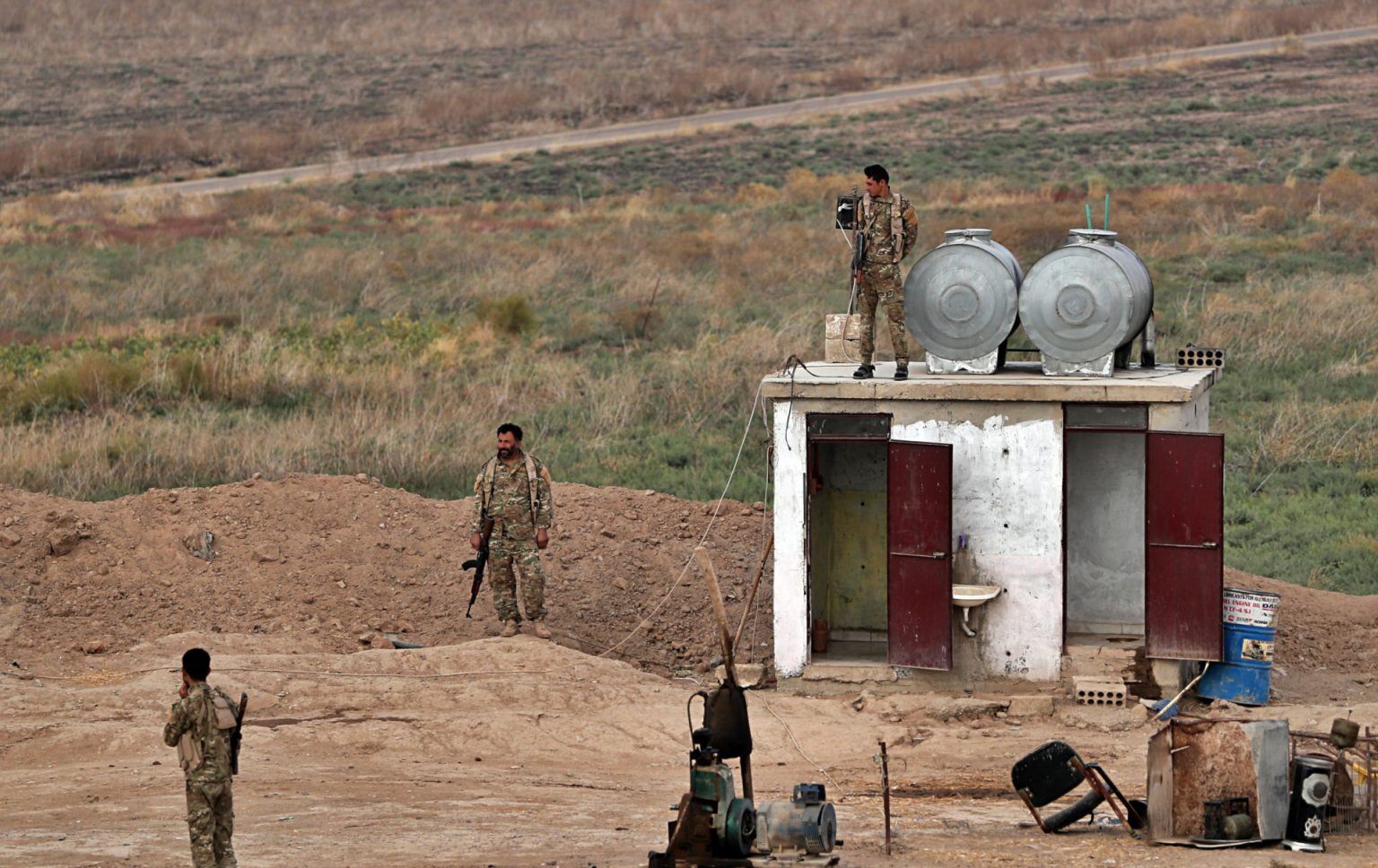
SDF fighters at the Syrian side of the al-Ya’rubiyah border crossing with Iraq – October 16, 2019 (AP)
Semalka: AANES’s escape from suffocating economy
Northeastern Syria is presumably one of the wealthiest regions in the country, being a concentration area for multiple resources, such as oil fields. However, the region continues to suffer in the throes of a deteriorating economy almost like the regions controlled by the Syrian regime. This deterioration has been largely associated with AANES’s financial policies and decisions.
Even though most of the Syrian oil fields are located in northeastern Syria, the region is still unable to establish its own economy. This failure has its causes rooted in the economic governance policies of the Syrian regime. The regime was keen on building a regionally interdependent economy. Syrian areas were forced to exchange resources to financially survive the integral economic system built on mutual needs that could only collapse should any of the cities or governorates refuse to be part of the need-based equation.
The Syrian economist, Dr. Firas Shaabo, explained to Enab Baladi the nature of the border-crossings-economic-relationship that ties the AANES to Iraqi Kurdistan.
Economist Shaabo said that trade through border crossings has developed into a fully-fledged type of commerce bringing extraordinary profits to those in control of the borders, let them be the AANES, the Syrian regime, or the opposition factions in northwestern Syria.
Both the AANES and Iraqi Kurdistan have their own relatively distinct regional traits, economic characteristics, human and industrial resources. The AANES is seeking this cooperation with Iraqi Kurdistan to establish a closed economy, independent from Turkey. However, the situation imposes certain conditions on both sides, for Iraqi Kurdistan cannot give up on valuable Turkish products or machinery, Shaabo said.
He added that the AANES could use internal crossings but for limited purposes, such as wheat for oil exchanges, or slender privileges within the regime-held areas.
Shaabo noted that, essential as it is, the Semalka crossing does not offer an ultimate substitute for internal crossings. Both the AANES and the regime are well aware they need each other and that they are involved in an exchange-based relationship. They recognize this relationship is important and must continue intact. The regime needs oil from the AANES’s areas, while the AANES is reluctant to sever ties with the regime altogether, fearing a deal in which it would be the biggest loser.
Shaabo added that the reopening of the Semalka crossing is the AANES’s means to release the pressure the areas it controls are suffering, just like the rest of other Syrian areas which are struggling with similar challenges and seeking to ease their own burdens.
As for Iraqi Kurdistan, the KRG imports a wide range of products from Turkey, while attempting to create an economic entity or body that units its areas to those controlled by the AANES. Shaabo believes it is difficult for these attempts to succeed given the variables predominating the two regions.
He added that such an economic agreement would not save the AANES from the economic hell grabbing its areas.
The variables governing the opening of the border crossing and the sought economic connections include political and personal disputes between the concerned sides, for these sides are particularly the guarantee to the success of the role awaited from these connections and which will be more profitable for the AANES than Iraqi Kurdistan because the latter is open to a vaster economic space.
Accordingly, Shaboo said that keeping the crossing open, the purposes it serves, and its ability to aid the AANES are all subject to the international, regional, and domestic understandings of the two sides running the border.
The economic relationship between the regime and the AANES started after the IS was expelled from Raqqa in October 2017. The regime purchased oil relaying on affiliated commercial proxies, most notably the Syrian businessman Hossam al-Katerji. These oil deals were the AANES’s clear expression that it is unwilling to provoke the regime, resuming oil sales after an interruption of 37 days.
Oil supplies were resumed after the AANES-run oil refineries in Tarhin, in al-Bab city, northeastern Aleppo were targeted by rockets from an unidentified source. Suspecting it is the regime, the AANES opted for resuming supplies fearing similar attacks.
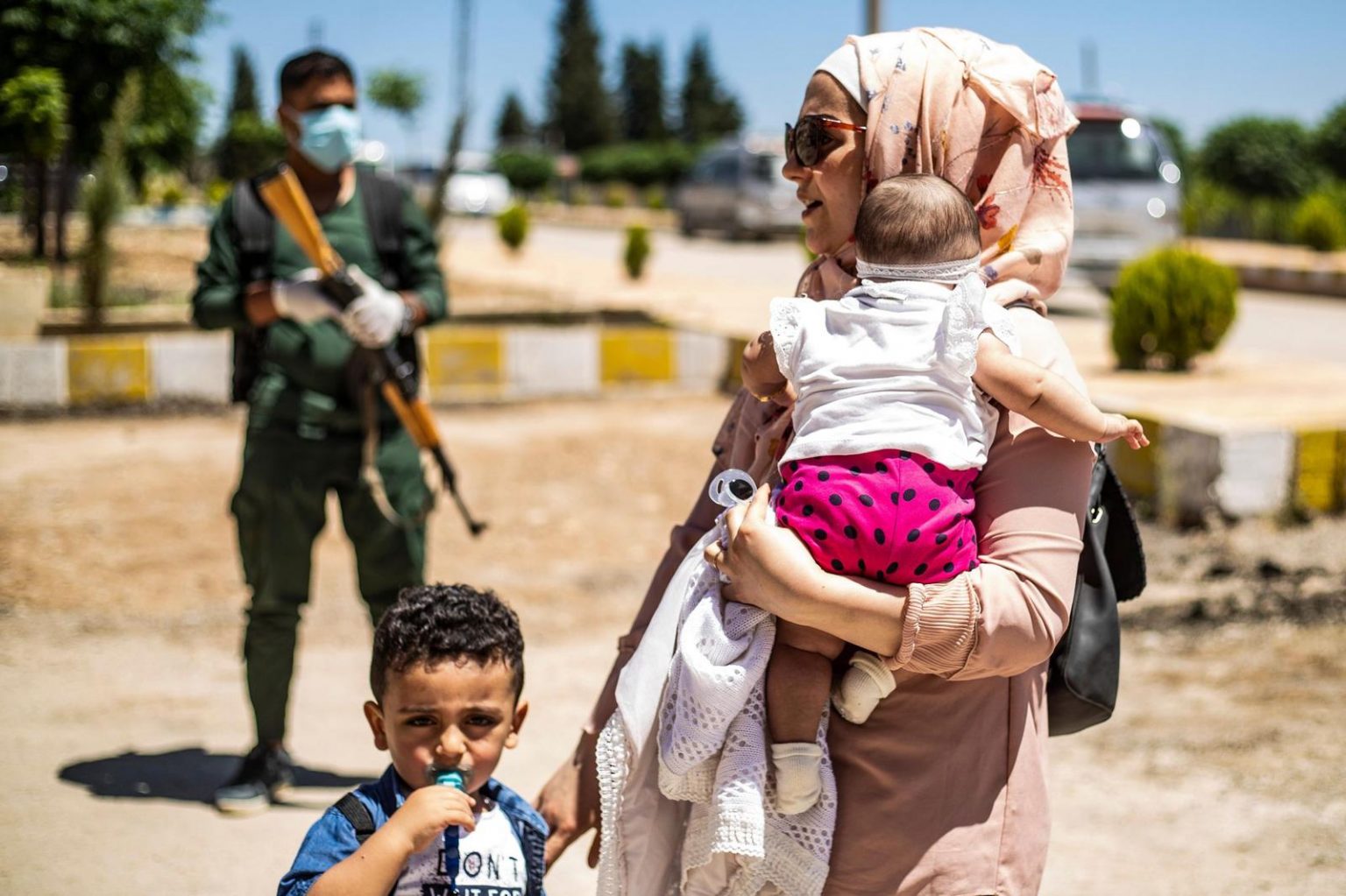
Families at the Semalka border crossing waiting for Iraqi border authorities to grant them access – 29 July 2020 (AFP).
Two crossings at the tri-border area
Semalka border crossing
The Semalka border crossing is established on the Syrian northeastern border strip with Iraq, separated from its Iraqi-mirror crossing Faysh Khabur, by the Khabur River, a tributary of the Euphrates River.
- The crossing is located in the Dohuk Governorate in the Kurdistan region, northern Iraq.
- The crossing was established in 2012, and its administration established a steel bridge over the Tigris River to facilitate the passage of goods.
- The crossing was opened after the Hawler meeting that brought together the People’s Council of Western Kurdistan and the Kurdish National Council (KNC) under the auspices of the leader of Iraqi Kurdistan Massoud Barzani.
- The crossing was originally established for trade purposes and the transfer of patients in need of treatment in Iraqi Kurdistan.
- The crossing was a passage for thousands of Syrians, who escaped the war and unemployment to Iraqi Kurdistan.
- The crossing is also used by civilians wishing to visit relatives in Iraqi Kurdistan, but under a number of conditions, in addition to Europeans or people with residence permits in Europe, merchants and brides.
- The US-led coalition uses the crossing to deliver military equipment to Syria, while humanitarian organizations use it to bring in aid.
- The Syrian regime accuses the US of shipping Syrian oil through the crossing.
Al-Ya’rubiyah border crossing
- It is also known as the Rabiaa crossing and is one of four formal border crossings between Syria and Iraq.
- It is located somewhere between al-Ya’rubiyah city, in al-Haskakah governorate, and Rabiaa city, in Iraqi Kurdistan.
- In 2013, the IS took over the crossing, which the SDF retook late the same year as it controlled the city.
- The crossing was a lifeline through which UN-coordinated humanitarian aid was delivered through Iraqi Kurdistan until the Security Council decided it should be closed under a Russian veto against its reauthorization in 2020.
- The Free Syrian Army accused the Iraqi army of shelling the crossing when it was under its control on 2 March 2013.
- It has a strategic location, as it expands over the highway connecting Syria to Mousl.
- The crossing, when it fell to IS control, played a key role in the hardliner group’s ability to announce the Caliphate on both sides of the border.
Political tensions
The tension regarding the border crossings between the KRG and the AANES areas raises several questions, as to the nature of the political goals behind these stressed relations and also as to what impact would tension have on the Kurdish-Kurdish dialogue that has been stagnant since October 2020.
The spokesperson for the Syrian Democratic Council (SDC), Amjad Othman, stressed the need for separating political rivalries from the humanitarian situation, adding that border crossings are critical for Syrians, particularly given the blockade and the sanctions imposed on Syria, the intra-disputes between the warring parties, and accompanying exchanged pressure.
Othman told Enab Baladi that the humanitarian condition in Syria is fragile under the restrictions obstructing Syrian’s movement between Syrian governorates to meet their needs. This fragility boosted the importance of the role played by crossings that have been contributing to humanitarian responses.
He added and this is also the reason why the Semalka border has been a necessity because it has contributed to easing the siege enforced on citizens, for all Syrian nationals can use the crossing headed to Iraqi Kurdistan, including patients seeking medical care, spouses, merchants, expatriates coming from Europe to visit their relatives, and humanitarian organizations’ workers.
Othman pointed out that the bureaucratic measures recently imposed by the KRG—namely, the excessive personal information that travelers across the border need to provide to authorities— stand as an obstacle between people and their humanitarian needs, adding that the AANES has denounced these measures and participated in discussions regarding the crossing with the Iraqi side.
Othman hopes that political differences will remain far from Semalka because it is a humanitarian crossing in the first place.
The importance of starting a dialogue
Othman said that, for the current stage, it is essential that all sides to the border crossings issue search for and build on common grounds. Iraqi Kurdistan shares various concerns and struggles with the areas in northeastern Syria. Both regions are focused on the war on “terrorism” and the threat posed by IS to their security and stability.
Iraqi Kurdistan “is not immune to the regional threats affecting the [AANES’s] areas, and these basic issues are should be used to create an oriented atmosphere for their relations, should [the two sides] have a conviction for that,” Othman said.
He added that while all parties to the conflict in Syria are suffering from pressure for failing to achieve a shared political solution, the AANS is encountering great challenges, manifested in undermining the project it stands for by all military, political, and security means.
Othman said that these pressures can be overcome only through establishing dialogue channels with all parties as to eliminate negative assumptions and excessive concerns over the AANES’s work, pointing that so far neither local, nor regional, nor international sides have shown the will to start discussing a solution and seek stability.
The border crossing must not be subject to debate
The Syrian rights activist Luqman Ayaneh said that disputes between the different parts of Kurdistan have always adversely affected the position of the Semalka crossing.
Ayaneh told Enab Baladi that, since it was opened in 2012, the closure of Semalka crossing was always an outcome to the parties to the Kurdistan region’s contentions outside Syria. “The latest disputes between Qandil and Hawler were one of the key reasons for the recent happenings,” he said, referring to the disagreements between the PKK and the KRG and its capital Erbil.
He said that the AANES must distance itself from the agendas of Kurdish parties and their squabbles, and also leave the border crossing out of the political bids because it is an important and necessary humanitarian crossing for the region.
He added that Semalka crossing is the lifeline for the areas in northeastern Syria under the blockade imposed on the AANES and that closing the crossing would deny locals access to life-saving supplies.
Ayaneh stressed that the crossing must not be subject to political considerations, which was clearly expressed in the Semelka Border Crossing’s administration’s statement on 22 June.
Semalka: the only crossing
For her part, Kurdish activist Zozan Aloush said that political goals have urged the regional government’s new measures against Syrians entering its regions through the Semalka crossing, which is northeastern Syria’s residents’ only exit point.
“Regretfully, the Kurdistan regional government, particularly Erbil, still see in northeastern Syria an area to expand over and boost its political hegemony through local partners. Even though the AANES has repeatedly expressed that it is open to communicate and cooperate with neighbor countries, including Iraqi Kurdistan,” Aloush told Enab Baladi.
She associated the border crossing tensions with the escalation Iraqi Kurdistan is witnessing and the Turkish airstrikes it is suffering, in addition to a few economic reasons.
As for solutions, she added that the AANES is not a “superman”, for it is surrounded and by several parties.
Aloush said that the AANES can only “focus on its inherent abilities and strengthen its local economy to overcome the siege and the pressure imposed on it by the KRG, the Syrian regime, and Turkey.”
She stressed that “dialogue and only dialogue” is the means to overcome tension, for the Syrian crisis has confirmed that weapons and military escalation do not result in a sustainable solution, but only temporary outcomes.

Families waiting at the Semalka border crossing for Iraqi border authorities to allow them in – 29 July 2020 (AFP)
Destiney of intra-Kurdish talks
The Kurdish-Kurdish talks have been frozen since October 2020 due to the US elections that ended with the victory of Joe Biden and the departure of the US adviser to the International Coalition in northern and eastern Syria, and the US diplomatic team to the United States.
The talks were stagnant except for a few statements by the AANES’ officials, notably the SDF commander Mazloum Abdi.
Last March, Abdi called on the KNC and the Kurdish National Unity Parties to resume talks, considering that the unity of the Kurdish ranks a strategic issue of importance for the future and setting the Kurdish household into order.
He also stressed the need for the two parties to show a spirit of responsibility and to return to the negotiation table to continue the discussion on the remaining controversial points face to face and not through the media.
Fuad Aliko, a member of the KNC, confirmed to Enab Baladi on June 26 that the Kurdish-Kurdish talks are on hold, waiting for the US envoy who is currently in Washington.
He added that talks will be resumed from where they stopped once the envoy is back into the east of the Euphrates areas.
The Kurdish-Kurdish dialogue is led by the US-backed PYD— the nucleus of the AANES— and the KNC— close to Ankara and Iraqi Kurdistan, and affiliated with the Syrian opposition. The PYD had previously closed the KNC offices, arrested a number of its members, and expelled its military group.
Activist Zozan Alloush believes that the tensions between the AANES and the KRG over the crossings will affect the Kurdish-Kurdish dialogue, especially since Erbil is baking one of the parties to the dialogue.
She added that it is necessary to focus on the dialogue and separate it from all other matters and regardless of the circumstances.
She said that the course of the situation cannot be predicted because the economic challenges the AANES is encountering and the lack of outlets and humanitarian crossings are affecting its political and economic negotiation trends and suggested solutions.
Human rights activist Luqman Ayaneh agrees with Alloush that tensions over the crossings tie into the political dialogue between the two Kurdish parties.
He said that “the Kurdish disputes had and still have a direct impact on the Kurdish public opinion in Syria and its political activities because some of these disputes are related to certain parties within the Kurdish axes.”
He added that continuing the dialogue that long without reaching a final agreement is an affirmation of the absence of the will to achieve an agreement.
Ayaneh believes that the will of the US sponsor and its arrangements for the future of northeastern Syria will be strongly present to ensure the success and finalization of the dialogue.
For his part, the spokesperson for the Syrian Democratic Council (SDC), Amjad Othman, blamed the KNC representatives for the disrupted Kurdish-Kurdish dialogue.
He said that “the [KNC’s] representatives still do not seem serious. This might be because they do not have a clear vision of the dialogue or because they did not appear ready to approach the dialogue as a determinant and strategic matter. They are, to the moment and at best, perceiving the dialogue as a political matter through which they can achieve some goals and benefits, and possibly some extra time.”
Othman believes that any development regarding the relationship with the KRG will undoubtedly cast a negative or positive shadow on the Kurdish dialogue in Syria, noting that the success of the dialogue may contribute to creating more opportunities to protect the Kurdish people. “The Kurds are subject to more attacks, and their national existence is still a target, as in Afrin and Ras al-Ain,” he said, adding that the Kurdish situation is “extremely critical.”
if you think the article contain wrong information or you have additional details Send Correction
النسخة العربية من المقال
-
Follow us :












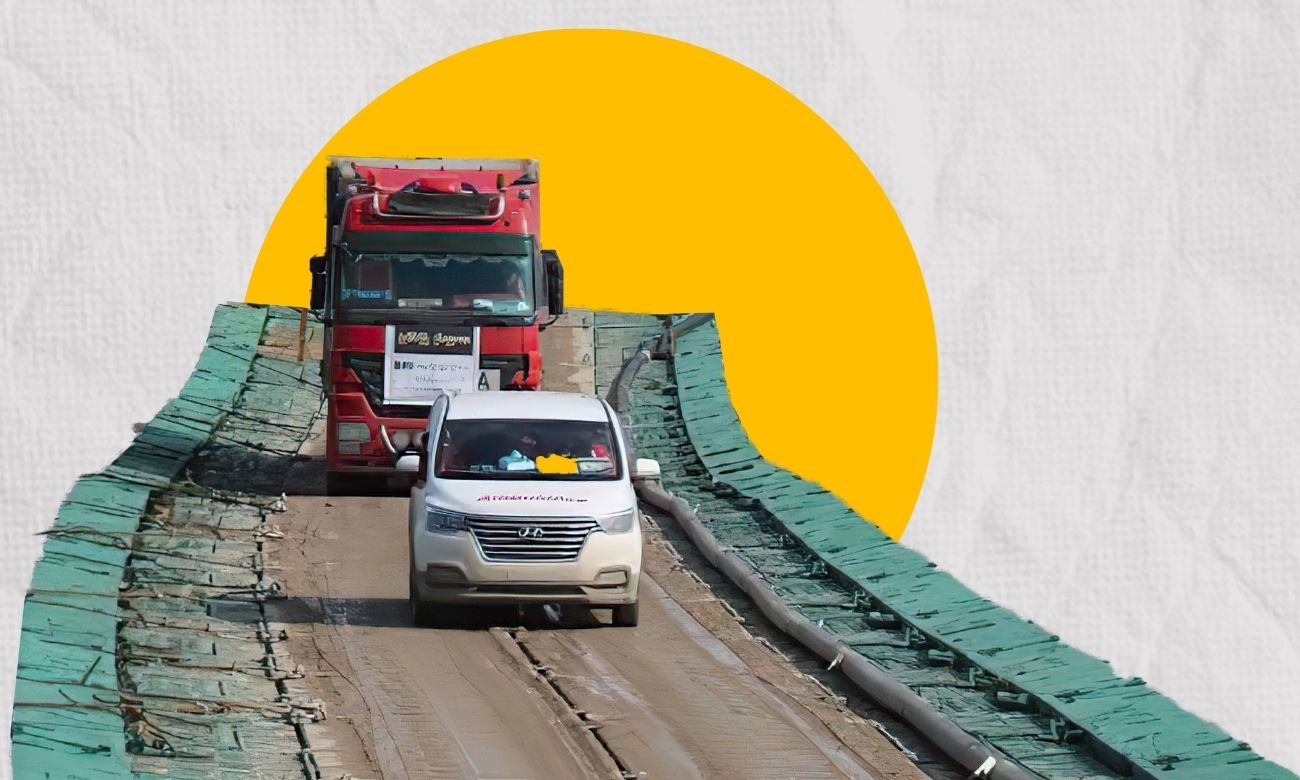
 Semalka Border Crossing (North Press/Edited by Enab Baladi)
Semalka Border Crossing (North Press/Edited by Enab Baladi)





 A
A
A
A
A
A

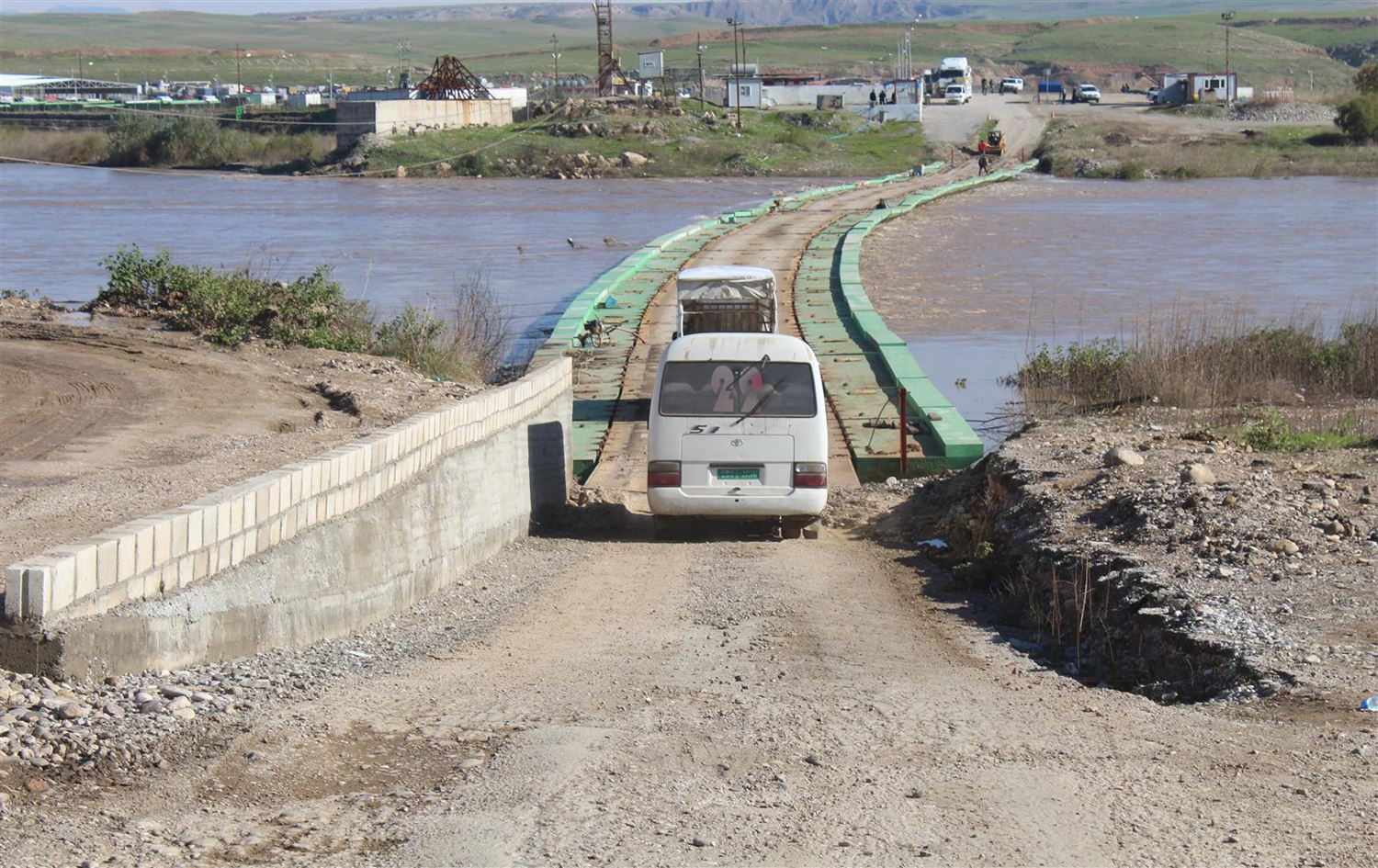
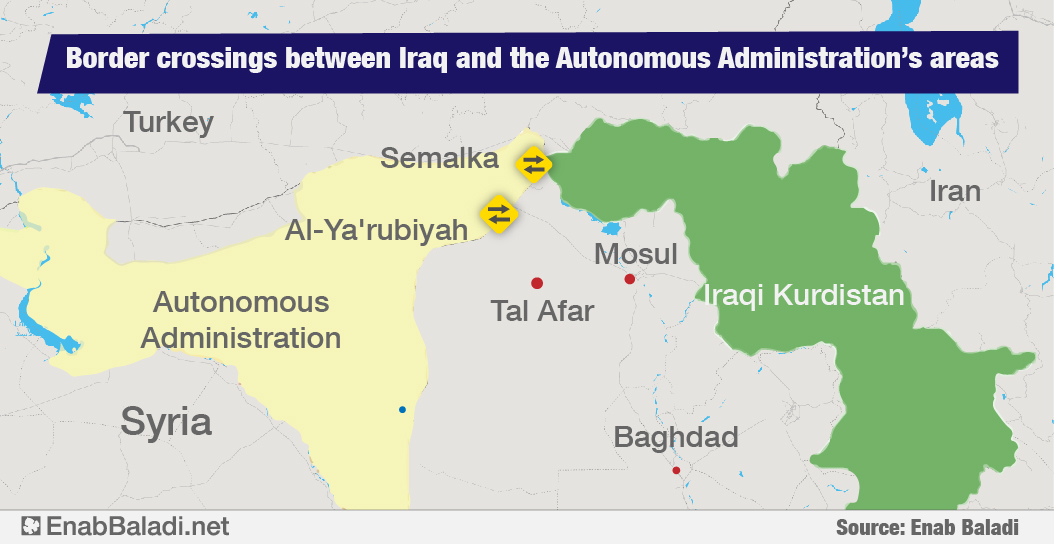




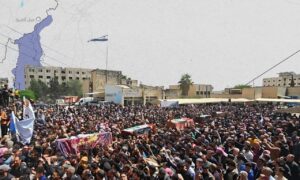



 More In-Depth
More In-Depth